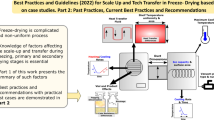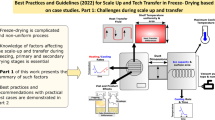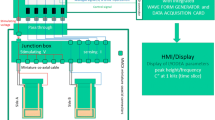Abstract
Although several guidelines do exist for freeze-drying process development and scale-up, there are still a number of issues that require additional attention. The objective of this review article is to discuss some emerging process development and scale-up issue with emphasis on effect of load condition and freeze-drying in novel container systems such as syringes, Lyoguard trays, ampoules, and 96-well plates. Understanding the heat and mass transfer under different load conditions and for freeze-drying in these novel container systems will help in developing a robust freeze-drying process which is also easier to scale-up. Further research and development needs in these emerging areas have also been addressed.


Similar content being viewed by others
Notes
Treated with methylated spirit and air dried.
REFERENCES
Hatley RHM, Mant A. Determination of the unfrozen water content of maximally freeze-concentrated carbohydrate solutions. Int J Biol Macromol. 1993;15(4):227–32.
Pikal MJ. Freeze-drying of proteins: process, formulation, and stability. ACS Symp Ser. 1994;567:120–33. Formulation and Delivery of Proteins and Peptides.
Rambhatla S, Ramot R, Bhugra C, Pikal MJ. Heat and mass transfer scale-up issues during freeze drying: II. Control and characterization of the degree of supercooling. AAPS PharmSciTech. 2004;5(4):e58.
Patel SM, Pikal MJ. Process analytical technologies (PAT) in freeze-drying of parenteral products. Pharm Dev Technol. 2009;14(6):567–87.
Rambhatla S, Pikal MJ. Heat and mass transfer scale-up issues during freeze-drying, I: atypical radiation and the edge vial effect. AAPS PharmSciTech. 2003;4(2):111–20.
Rambhatla S, Tchessalov S, Pikal MJ. Heat and mass transfer scale-up issues during freeze-drying, III: control and characterization of dryer differences via operational qualification tests. AAPS PharmSciTech. 2006;7(2):E39.
Searles J. Observation and implications of sonic water vapor flow during freeze-drying. Am Pharm Rev. 2004; 7(2):58, 60, 62, 64, 66–68, 75.
Patel SM, Jameel F, Pikal MJ. The effect of dryer load on freeze-drying process design. J Pharm Sci. 2010;99(10):4363–79.
Reynolds G. The market need for reconstitution systems: manufacturers and consumers can benefit from these advanced systems. Pharm Process. 2006
Polin JB. The ins and outs of prefilled syringes. Pharm Med Packag News. 2003;11(5):40–3.
Swain E. Functional packages protect and deliver. Pharm Med Packag News. 2001
Pikal MJ. Use of laboratory data in freeze drying process design: heat and mass transfer coefficients and the computer simulation of freeze drying. PDA J Pharm Sci Technol. 1985;39(3):115–39.
Pikal MJ, Roy ML, Shah S. Mass and heat transfer in vial freeze-drying of pharmaceuticals: role of the vial. J Pharm Sci. 1984;73(9):1224–37.
Hottot A, Andrieu J, Vessot S, Shalaev E, Gatlin LA, Ricketts S. Experimental study and modeling of freeze-drying in syringe configuration. Part I: freezing step. Drying Technol. 2009;27(1):40–8.
Hottot A, Andrieu J, Hoang V, Shalaev EY, Gatlin LA, Ricketts S. Experimental study and modeling of freeze-drying in syringe configuration. Part II: mass and heat transfer parameters and sublimation end-points. Drying Technol. 2009;27(1):49–58.
Patel SM, Pikal MJ. Freeze-drying in novel container system: characterization of heat and mass transfer in glass syringes. J Pharm Sci. 2010;99(7):3188–204.
Roy ML, Pikal MJ. Process control in freeze drying: determination of the end point of sublimation drying by an electronic moisture sensor. PDA J Pharm Sci Technol. 1989;43(2):60–6.
Patel SM, Doen T, Pikal MJ. Determination of end point of primary drying for freeze-drying process control. AAPS PharmSciTech. 2010;11(1):73–84.
Gassier M, Rey L. Development of a new concept for bulk freeze-drying: LYOGUARD freeze-dry packaging. Drugs Pharm Sci. 2004;137:325–48. Freeze-Drying/Lyophilization of Pharmaceutical and Biological Products.
WHO. Guidelines for the preparation, characterization and estabishment of international and other standards and reference reagents for biological standardiation. WHO Tech Rep Ser. 1990;800:181–214.
de Grazio FL. Closure and container considerations in lyophilization. Drugs Pharm Sci. 2004;137:277–97. Freeze-Drying/Lyophilization of Pharmaceutical and Biological Products.
Donovan PD, Corvari V, Burton MD, Rajagopalan N. Effect of stopper processing conditions on moisture content and ramifications for lyophilized products: comparison of “low” and “high” moisture uptake stoppers. PDA J Pharm Sci Technol. 2007;61(1):51–8.
Earle JP, Bennett PS, Larson KA, Shaw R. The effects of stopper drying on moisture levels of Haemophilus influenzae conjugate vaccine. Dev Biol Stand. 1992;74:203–10. Biol. Prod. Freeze-Drying Formulation.
Pikal MJ, Shah S. Moisture transfer from stopper to product and resulting stability implications. Dev Biol Stand. 1992;74:165–79. Biol. Prod. Freeze-Drying Formulation.
Templeton AC, Placek J, Xu H, Mahajan R, Hunke WA, Reed RA. Determination of the moisture content of bromobutyl rubber stoppers as a function of processing: implications for the stability of lyophilized products. PDA J Pharm Sci Technol. 2003;57(2):75–87.
Matejtschuk P, Rafiq S, Johnes S, Gaines Das R. A comparison of vials with ampoules for the storage of biological reference materials. Biologicals. 2005;33(2):63–70.
Ford AW, Dawson PJ. Effect of type of container, storage temperature and humidity on the biological activity of freeze-dried alkaline phosphatase. Biologicals. 1994;22(2):191–7.
Phillips PK, Dawson PJ, Delderfield AJ. The use of DIN glass ampoules to freeze-dry biological materials with a low residual moisture and oxygen content. Biologicals. 1991;19(3):219–21.
Graberg S, Hyla W, Gieseler H. Freeze Drying from small product containers to its implication on freeze-drying process design: evaluation of heat transfer coefficient of a new 96-well freeze drying system in comparison to 2R tubing vials and polypropylene 96-well PCR-plates. CPPR Freeze Drying of Pharmaceuticals and Biologicals. Breckenridge, Colorado; 2008
Graberg S, Gieseler H. Freeze drying in non-vial container systems: evaluation of heat transfer coefficients of PCR-plates and correlation to freeze-drying cycle design. CPPR Freeze-Drying of Pharmaceuticals and Biologicals. Garmisch-Partenkirchen, Germany; 2006
Hottot A, Peczalski R, Vessot S, Andrieu J. Freeze-drying of pharmaceutical proteins in vials: modeling of freezing and sublimation steps. Drying Technol. 2006;24(5):561–70.
Millman MJ, Liapis AI, Marchello JM. An analysis of the lyophilization process using a sorption-sublimation model and various operational policies. AIChE J. 1985;31(10):1594–604.
Pikal MJ, Cardon S, Bhugra C, et al. The nonsteady state modeling of freeze drying: in-process product temperature and moisture content mapping and pharmaceutical product quality applications. Pharm Dev Technol. 2005;10(1):17–32.
Sadikoglu H, Liapis AI. Mathematical modeling of the primary and secondary drying stages of bulk solution freeze-drying in trays: parameter estimation and model discrimination by comparison of theoretical results with experimental data. Drying Technol. 1997;15(3 & 4):791–810.
Sheehan P, Liapis AI. Modeling of the primary and secondary drying stages of the freeze drying of pharmaceutical products in vials: numerical results obtained from the solution of a dynamic to spatially multi-dimensional lyophilization model for different operational policies. Biotechnol Bioeng. 1998;60(6):712–28.
Velardi SA, Barresi AA. Development of simplified models for the freeze-drying process and investigation of the optimal operating conditions. Chem Eng Res Des. 2008;86(1):9–22.
Nakagawa K, Hottot A, Vessot S, Andrieu J. Modeling of freezing step during freeze-drying of drugs in vials. AIChE J. 2007;53(5):1362–72.
Patel SM, Chaudhuri S, Pikal MJ. Choked flow and importance of Mach 1 in freeze-drying process. Chem Eng Sci. 2010;65 (21):5716–27.
Author information
Authors and Affiliations
Corresponding author
Additional information
Guest Editors: Lavinia Lewis, Jim Agalloco, Bill Lambert, Russell Madsen, and Mark Staples
Rights and permissions
About this article
Cite this article
Patel, S.M., Pikal, M.J. Emerging Freeze-Drying Process Development and Scale-up Issues. AAPS PharmSciTech 12, 372–378 (2011). https://doi.org/10.1208/s12249-011-9599-9
Received:
Accepted:
Published:
Issue Date:
DOI: https://doi.org/10.1208/s12249-011-9599-9




